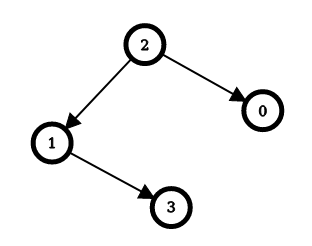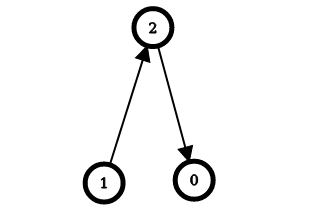可以到达每一个节点的最少边反转次数
难度:
标签:
题目描述
There is a simple directed graph with n nodes labeled from 0 to n - 1. The graph would form a tree if its edges were bi-directional.
You are given an integer n and a 2D integer array edges, where edges[i] = [ui, vi] represents a directed edge going from node ui to node vi.
An edge reversal changes the direction of an edge, i.e., a directed edge going from node ui to node vi becomes a directed edge going from node vi to node ui.
For every node i in the range [0, n - 1], your task is to independently calculate the minimum number of edge reversals required so it is possible to reach any other node starting from node i through a sequence of directed edges.
Return an integer array answer, where answer[i] is the minimum number of edge reversals required so it is possible to reach any other node starting from node i through a sequence of directed edges.
Example 1:

Input: n = 4, edges = [[2,0],[2,1],[1,3]] Output: [1,1,0,2] Explanation: The image above shows the graph formed by the edges. For node 0: after reversing the edge [2,0], it is possible to reach any other node starting from node 0. So, answer[0] = 1. For node 1: after reversing the edge [2,1], it is possible to reach any other node starting from node 1. So, answer[1] = 1. For node 2: it is already possible to reach any other node starting from node 2. So, answer[2] = 0. For node 3: after reversing the edges [1,3] and [2,1], it is possible to reach any other node starting from node 3. So, answer[3] = 2.
Example 2:

Input: n = 3, edges = [[1,2],[2,0]] Output: [2,0,1] Explanation: The image above shows the graph formed by the edges. For node 0: after reversing the edges [2,0] and [1,2], it is possible to reach any other node starting from node 0. So, answer[0] = 2. For node 1: it is already possible to reach any other node starting from node 1. So, answer[1] = 0. For node 2: after reversing the edge [1, 2], it is possible to reach any other node starting from node 2. So, answer[2] = 1.
Constraints:
2 <= n <= 105edges.length == n - 1edges[i].length == 20 <= ui == edges[i][0] < n0 <= vi == edges[i][1] < nui != vi- The input is generated such that if the edges were bi-directional, the graph would be a tree.
代码结果
运行时间: 357 ms, 内存: 101.0 MB
/*
* 使用Java Stream API来构建图,并计算每个节点的最小反转次数。
* 利用广度优先搜索(BFS)来计算每个节点作为起点到达其他所有节点的最少反转次数。
* 用Dijkstra算法求解每个节点作为起点的最短路径。
*/
import java.util.*;
import java.util.stream.*;
public class SolutionStream {
public int[] minReversals(int n, int[][] edges) {
List<int[]>[] graph = IntStream.range(0, n).mapToObj(i -> new ArrayList<int[]>()).toArray(ArrayList[]::new);
Arrays.stream(edges).forEach(edge -> {
graph[edge[0]].add(new int[]{edge[1], 0});
graph[edge[1]].add(new int[]{edge[0], 1});
});
return IntStream.range(0, n).map(i -> dijkstra(graph, n, i)).toArray();
}
private int dijkstra(List<int[]>[] graph, int n, int start) {
int[] dist = new int[n];
Arrays.fill(dist, Integer.MAX_VALUE);
dist[start] = 0;
PriorityQueue<int[]> pq = new PriorityQueue<>(Comparator.comparingInt(a -> a[1]));
pq.add(new int[]{start, 0});
while (!pq.isEmpty()) {
int[] current = pq.poll();
int node = current[0];
int distance = current[1];
if (distance > dist[node]) continue;
for (int[] edge : graph[node]) {
int neighbor = edge[0];
int weight = edge[1];
int newDist = dist[node] + weight;
if (newDist < dist[neighbor]) {
dist[neighbor] = newDist;
pq.add(new int[]{neighbor, newDist});
}
}
}
return Arrays.stream(dist).max().orElse(Integer.MAX_VALUE);
}
}
解释
方法:
时间复杂度:
空间复杂度: